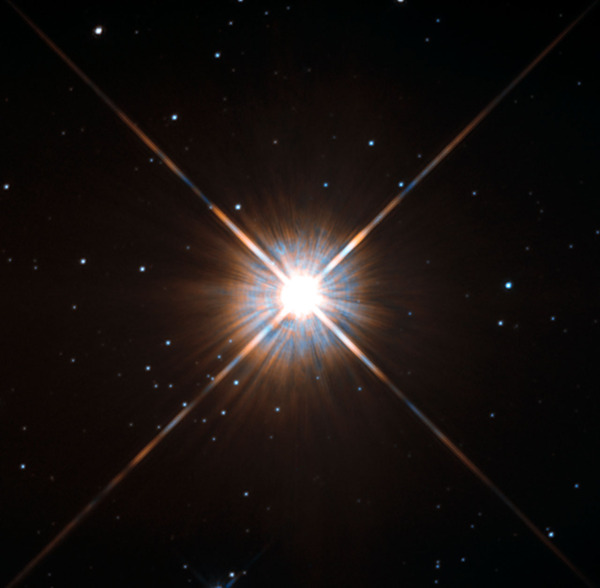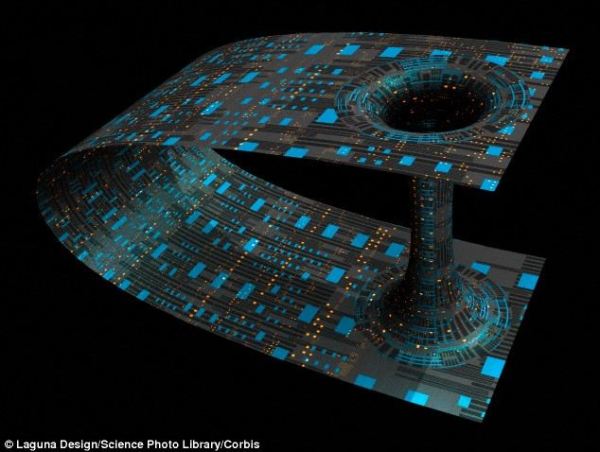If you wanted to travel to the stars -- and by that, I mean star systems beyond our own -- you'd better be prepared to take your sweet time. Even at the speeds the Apollo astronauts traveled to the Moon, it would take millions of years to reach even the next nearest star beyond our own, Proxima Centauri.
 Image credit: ESA/Hubble & NASA, via http://www.spacetelescope.org/images/potw1343a/.
Image credit: ESA/Hubble & NASA, via http://www.spacetelescope.org/images/potw1343a/.
And yet, General Relativity admits an astounding possibility to short-cut the great cosmic distances by punching a hole in spacetime, connecting two far-separated events to one another through a cosmic bridge: a wormhole.
What strikes us as the most fanciful of science fiction ideas may legitimately someday become science fact. Find out where we stand via Paul Halpern's great piece: the Physics of Wormholes!
- Log in to post comments


Nice article, what a pity it's pseudoscience from the off. Because a concentration of energy "conditions" the surrounding space, making it inhomogeneous. So light moving through it curves because "the speed of light varies with position". Imagine you place light-clocks throughout an equatorial slice through the Earth and surrounding space. When you plot the clock rates you get a "curved spacetime" plot like the one in the article. But space isn't curved, so curving it to make a wormhole doesn't make sense. And there's no motion in spacetime, because it models space at all times. The idea of moving through spacetime from one point to another is a tautology. So it doesn't make sense to contrive a wormhole out of curved spacetime either. People should know this, because a wormhole permits time travel. Time is a measure of local motion, you can't move through a measure of motion. So time travel is science fiction, and so is a wormhole, and so is Interstellar. .
I'm going to take a slightly different track here.
Wormholes of sufficient capacity to handle ark ships would be nice but aren't essential, and I don't think they are going to become practical.
We should be able to achieve viable interstellar travel with technologies that are presently foreseeable such as fusion-based propulsion. At a mid-single-digit percentage of c, we can build many-generational ark ships for multi-thousand-year voyages. That would be sufficient to enable the lineage of Earth to spread to the cosmos.
If it's feasible to find or create wormholes at all, they will likely be tiny, but potentially sufficient to serve as conduits for signals.
Thus they could be used as part of an interstellar communications system.
That isn't quite the "ansible" of science fiction fame (instant communication anywhere), but it's useful for cutting the round-trip time to the point where working relationships can be maintained.
Consider a star 30 LY away, where travel at 0.01c takes 3,000 years and conventional round-trip communication at c takes 60 years (thus making any interaction a multi-generational project). Now reduce the round trip communication to e.g. 3 years, and scientists at both ends could collaborate in a reasonable way.
@John
if you write down the simplest form of einstein field equations, you will see how contradictory your claims are with reality.
On the left hand side you have the einstein tensor which is a quantification of metric tensor's change is space and time (geometry), and on the right hand side you have Pi, G and energy-momentum tensor (matter). You always choose (in order to seem right) to neglect the momentum part. But you can't. It's there.
Since the left hand side is geometry and right hand side is energy and momentum, even I can follow this equation and it's meaning. You can say curvature dictates matter distribution, but you can also say matter distribution dictates curvature.
You call it pseudo-science and whatnot.. did you even bother reading the einstein's paper quoted in the article?
Sinisa: I've read the paper before. And what I'm saying is all about reality. Your metric is all to do with “what you measure”. So when you plot those equatorial clock-rates you get a curved metric. But see Baez, space isn’t curved. Instead it's inhomogeneous. Only it isn’t some straight-line inhomogeneity, there’s a geometry to it. And it’s caused by a concentration of energy usually in the guise of matter. Note the shear stress term in the stress-energy-momentum tensor? It’s like space is a ghostly gin-clear elastic, and the concentration of energy is like inserting more of the same in the middle. It’s like it pushes the surrounding space outwards altering its metrical properties. Yes, you can say matter distribution dictates curvature, but it isn’t the curvature of space, it’s the curvature in your plot of measurements in space over time, and we call it curved spacetime.
@ John:
metric is really simple, so no need for abstraction " is all about "what you measure"". Metric is a function that measures distance between two points or two vectors in a coordinate system. Pure and simple. In our case, 3 space and one time coordinate. Metric isn't about plotting dots and then connecting the lines, saying metric curves... quite the opposite, metric tells you where to plot the dots.. it tells you what the distance will be between dots or vectors, and then when you connect them you see that the trajectory of body in space is curved, and that's what we observe as well. This is why I find your arguments of not space.. and only time, quite strange. There are 4 coordinates(dimensions)... all of equal status. Time is no special or only one. And the metric form depends on how many dimensions you choose.
The second part of what you say is self defeating if you read it carefully. It's like saying.. "no, the earth's surface is not round or curved, it's your trajectory when you walk across it that curves... but the earth isn't curved". Objects follow straight lines... or in other words.. the path of least resistance... in other words.. the space is curved, and the object follows the straight line through it... exactly the same as earth and us on it. You can argue about energy inhomogeneity, but that won't change the fact that the surface of the earth is a curved 2D space (aproximated ofc... no need for himalays and grand canyon). There is no time or energy needed to understand that. And mathematically that's what we use. That's where it begins.. with the surface of the sphere, then one additional space dimension... which is again projected as new coordinate and the angle of that coordinate to the point we choose on the surface of the sphere, and then one additional component for time.. and that's how we get the FRW metric.
p.s. sorry.. disregard the last part... "that's how we get the FRW metric".. it stayed from something I deleted, because it was going into details which aren't that important
No probs. Note thought that your coordinate system is an abstract thing, typically defined using the motion of light through space over time. And wherever your plot of equatorial light-clocks shows a gradient, light moving through space will curve, because the speed of light varies with position. That’s what Einstein said. He never said light curves because spacetime is curved. You don’t need a curvature in your plot for light to curve, you need a gradient. So don’t get confused by the curvature of the Earth. A beam of light doesn’t curve because space is curved. Space isn’t curved where a gravitational field is. And light doesn’t curve because spacetime is curved either. It curves because spacetime is “tilted”. Look at the spacetime depictions, light curves and things fall down wherever there’s a slope. This is equivalent to space being inhomogeneous. See this for more information. As for what I say about time rather than space, the four dimensions are not of equal status, remember the minus sign, and note that you have freedom of motion through space, but not through time. The latter is derived from motion through space, which is why your motion through space relative to me alters your time as compared to mine.
Indeed, SL.
The geodesic on a sphere tells you where to plot the dots to get from A to B on the sphere in the shortest possible distance.
The geodesic is a metric. It can be calculated.
And orbital mechanics plots a metric using differing coordinate systems to optimise a path for fuel use, time taken or (if we have an abundance of riches in the energy department), shortest distance.
And the GR metric tells us where the dots connecting the shortest distance between two points should be plotted. Not the other way round. The other way round we can VERIFY the metric as correct. Just like we can show the earth is curved by seeing the difference between a rectilinear plot getting to a spot and a geodesic for a sphere for the same distance.
Indeed the nautical mile is ample proof that the earth is not flat since it isn't the same as the cartesian flat plane mile.
John, concerning #7. As you surely agree, GR is much more than just photons and how they behave. In fact, it has very little to do with photons if we want to be frank.
What you write about light, will not explain the precession of Mercury. I mean... yes, light obeys same laws as rest of the things, but our universe is not made only of photons and most of the motions are well in v<<c range.
If you want to impress people with how clever you are, stop depicting space as a flexible two dimensional surface being manipulated in three dimensions. It's terribly silly, and not relevant to the universe we live in, even when done by people with walls covered in sheep skin who should know better.
Space by definition and observable properties is not a two dimensional plane, and you can't say that it is by hand waving and cheesy CGI, any more than you can elide from 2 to 3 and say they are the same number just because you said so. In addition, manipulating any imaginary area or flat surface out of one spatial plane makes it a de facto three dimensional construct.
CFT,
I'd imagine that it's the same '2d look' no matter what azimuth and elevation you slice through the '3d', umm, space.
You must have one hellofa monitor to be able to depict it otherwise.
Sinisa: yes, GR is much more than just photons and how they behave. But that's where you start. For matter you then take note of pair production and treat the electron as a photon in a closed path. Simplify it to a square path, and only the horizontals curve downwards a little, and you can understand why light is deflected twice as much as matter. Yes it gets more complicated with say precession, but to understand it you have to start with the simple stuff.